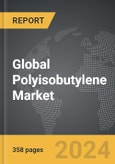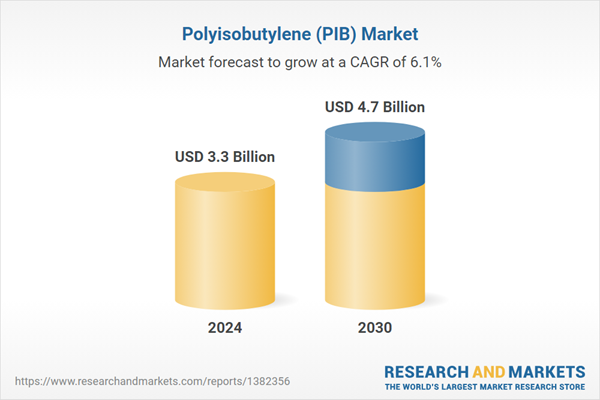The global market for Polyisobutylene (PIB) was valued at US$3.3 Billion in 2024 and is projected to reach US$4.7 Billion by 2030, growing at a CAGR of 6.1% from 2024 to 2030. This comprehensive report provides an in-depth analysis of market trends, drivers, and forecasts, helping you make informed business decisions. The report includes the most recent global tariff developments and how they impact the Polyisobutylene (PIB) market.
Segments: Product (Conventional PIB, Highly Reactive PIB); Molecular Weight (High Molecular Weight PIB, Medium Molecular Weight PIB, Low Molecular Weight PIB); End-Use (Transportation End-Use, Industrial End-Use, Food End-Use, Other End-Uses).
Geographic Regions/Countries: World; USA; Canada; Japan; China; Europe; France; Germany; Italy; UK; Spain; Russia; Rest of Europe; Asia-Pacific; Australia; India; South Korea; Rest of Asia-Pacific; Latin America; Brazil; Mexico; Rest of Latin America; Middle East; Africa.
The analysts continuously track trade developments worldwide, drawing insights from leading global economists and over 200 industry and policy institutions, including think tanks, trade organizations, and national economic advisory bodies. This intelligence is integrated into forecasting models to provide timely, data-driven analysis of emerging risks and opportunities.
Global Polyisobutylene (PIB) Market - Key Trends & Drivers Summarized
What Is Polyisobutylene (PIB) and Why Is It Significant?
Polyisobutylene (PIB) is a synthetic rubber, a polymer of isobutylene, and it is known for its excellent impermeability to gases, resistance to chemicals, and flexibility. This versatile material is widely used in various industries due to its unique properties. One of the most notable applications of PIB is in the automotive industry, where it is used in the production of inner tubes and linings for tires, contributing to enhanced air retention and durability. Additionally, PIB is utilized in the manufacture of adhesives, sealants, and lubricants. Its ability to form a protective barrier makes it essential in producing corrosion-resistant coatings and waterproofing materials. The combination of durability, flexibility, and chemical resistance makes PIB a significant material in both industrial and consumer applications.How Is Polyisobutylene Produced and What Are Its Key Characteristics?
Polyisobutylene is produced through the polymerization of isobutylene, typically using a cationic polymerization process. This process can be controlled to produce PIB with varying molecular weights, tailored for specific applications. The key characteristics of PIB include its low permeability to gases, excellent electrical insulation properties, and resistance to weathering and ozone. These properties make PIB an ideal material for applications requiring long-term durability and stability under harsh conditions. The material's flexibility and tackiness at different temperatures also contribute to its widespread use in adhesives and sealants, where it provides strong bonding and sealing performance. Furthermore, PIB’s non-toxicity and non-reactivity with most chemicals enhance its suitability for use in food-grade and medical applications.What Are the Emerging Trends and Innovations in the Polyisobutylene Market?
The polyisobutylene market is evolving with several emerging trends and innovations aimed at enhancing its performance and expanding its application scope. One significant trend is the development of high-performance PIB grades with improved properties such as higher thermal stability and better mechanical strength. Innovations in production technology, including the use of advanced catalysts and polymerization techniques, are enabling the creation of PIB with more precise molecular weight distributions and enhanced performance characteristics. Another notable trend is the growing use of PIB in sustainable and eco-friendly products. For instance, PIB-based materials are being increasingly utilized in biodegradable plastics and environmentally friendly adhesives. The rise of electric vehicles is also driving demand for high-quality PIB, as it is used in the production of energy-efficient tires and insulation materials for electric vehicle batteries.What Factors Are Driving the Growth in the Polyisobutylene Market?
The growth in the polyisobutylene market is driven by several factors, including technological advancements, increasing demand from the automotive and construction industries, and the expanding application of PIB in sustainable products. Technological innovations in production processes are enhancing the quality and performance of PIB, making it more attractive for various high-end applications. The automotive industry’s need for durable and efficient materials for tires and engine components is a significant driver, as PIB provides essential properties like air retention and chemical resistance. The construction industry’s demand for effective sealants and waterproofing materials is also propelling market growth. Additionally, the shift towards sustainable and environmentally friendly products is boosting the use of PIB in green applications, such as biodegradable plastics and eco-friendly adhesives. These factors collectively ensure the robust expansion of the polyisobutylene market, aligning with broader industrial and environmental trends.Report Scope
The report analyzes the Polyisobutylene (PIB) market, presented in terms of units. The analysis covers the key segments and geographic regions outlined below.Segments: Product (Conventional PIB, Highly Reactive PIB); Molecular Weight (High Molecular Weight PIB, Medium Molecular Weight PIB, Low Molecular Weight PIB); End-Use (Transportation End-Use, Industrial End-Use, Food End-Use, Other End-Uses).
Geographic Regions/Countries: World; USA; Canada; Japan; China; Europe; France; Germany; Italy; UK; Spain; Russia; Rest of Europe; Asia-Pacific; Australia; India; South Korea; Rest of Asia-Pacific; Latin America; Brazil; Mexico; Rest of Latin America; Middle East; Africa.
Key Insights:
- Market Growth: Understand the significant growth trajectory of the Conventional PIB segment, which is expected to reach US$2.5 Billion by 2030 with a CAGR of a 5.7%. The Highly Reactive PIB segment is also set to grow at 6.5% CAGR over the analysis period.
- Regional Analysis: Gain insights into the U.S. market, valued at $469.6 Million in 2024, and China, forecasted to grow at an impressive 8.1% CAGR to reach $1.1 Billion by 2030. Discover growth trends in other key regions, including Japan, Canada, Germany, and the Asia-Pacific.
Why You Should Buy This Report:
- Detailed Market Analysis: Access a thorough analysis of the Global Polyisobutylene (PIB) Market, covering all major geographic regions and market segments.
- Competitive Insights: Get an overview of the competitive landscape, including the market presence of major players across different geographies.
- Future Trends and Drivers: Understand the key trends and drivers shaping the future of the Global Polyisobutylene (PIB) Market.
- Actionable Insights: Benefit from actionable insights that can help you identify new revenue opportunities and make strategic business decisions.
Key Questions Answered:
- How is the Global Polyisobutylene (PIB) Market expected to evolve by 2030?
- What are the main drivers and restraints affecting the market?
- Which market segments will grow the most over the forecast period?
- How will market shares for different regions and segments change by 2030?
- Who are the leading players in the market, and what are their prospects?
Report Features:
- Comprehensive Market Data: Independent analysis of annual sales and market forecasts in US$ Million from 2024 to 2030.
- In-Depth Regional Analysis: Detailed insights into key markets, including the U.S., China, Japan, Canada, Europe, Asia-Pacific, Latin America, Middle East, and Africa.
- Company Profiles: Coverage of players such as BASF SE, Chevron Oronite Company LLC, Daelim Co., Ltd., ENEOS Corporation, INEOS Group Limited and more.
- Complimentary Updates: Receive free report updates for one year to keep you informed of the latest market developments.
Some of the 33 companies featured in this Polyisobutylene (PIB) market report include:
- BASF SE
- Chevron Oronite Company LLC
- Daelim Co., Ltd.
- ENEOS Corporation
- INEOS Group Limited
- Kothari Petrochemicals Limited
- Lubrizol Corporation
- Shandong Hongrui New Material Technology Co., Ltd.
- TER Chemicals GmbH & Co. KG
- TPC Group
- Zhejiang Shunda New Material Co., Ltd.
Tariff Impact Analysis: Key Insights for 2025
Global tariff negotiations across 180+ countries are reshaping supply chains, costs, and competitiveness. This report reflects the latest developments as of April 2025 and incorporates forward-looking insights into the market outlook.The analysts continuously track trade developments worldwide, drawing insights from leading global economists and over 200 industry and policy institutions, including think tanks, trade organizations, and national economic advisory bodies. This intelligence is integrated into forecasting models to provide timely, data-driven analysis of emerging risks and opportunities.
What’s Included in This Edition:
- Tariff-adjusted market forecasts by region and segment
- Analysis of cost and supply chain implications by sourcing and trade exposure
- Strategic insights into geographic shifts
Buyers receive a free July 2025 update with:
- Finalized tariff impacts and new trade agreement effects
- Updated projections reflecting global sourcing and cost shifts
- Expanded country-specific coverage across the industry
Table of Contents
I. METHODOLOGYII. EXECUTIVE SUMMARY2. FOCUS ON SELECT PLAYERSIII. MARKET ANALYSISCANADAITALYSPAINRUSSIAREST OF EUROPESOUTH KOREAREST OF ASIA-PACIFICBRAZILMEXICOREST OF LATIN AMERICAIV. COMPETITION
1. MARKET OVERVIEW
3. MARKET TRENDS & DRIVERS
4. GLOBAL MARKET PERSPECTIVE
UNITED STATES
JAPAN
CHINA
EUROPE
FRANCE
GERMANY
UNITED KINGDOM
ASIA-PACIFIC
AUSTRALIA
INDIA
LATIN AMERICA
MIDDLE EAST
AFRICA
Companies Mentioned (Partial List)
A selection of companies mentioned in this report includes, but is not limited to:
- BASF SE
- Chevron Oronite Company LLC
- Daelim Co., Ltd.
- ENEOS Corporation
- INEOS Group Limited
- Kothari Petrochemicals Limited
- Lubrizol Corporation
- Shandong Hongrui New Material Technology Co., Ltd.
- TER Chemicals GmbH & Co. KG
- TPC Group
- Zhejiang Shunda New Material Co., Ltd.
Table Information
| Report Attribute | Details |
|---|---|
| No. of Pages | 409 |
| Published | April 2025 |
| Forecast Period | 2024 - 2030 |
| Estimated Market Value ( USD | $ 3.3 Billion |
| Forecasted Market Value ( USD | $ 4.7 Billion |
| Compound Annual Growth Rate | 6.1% |
| Regions Covered | Global |









